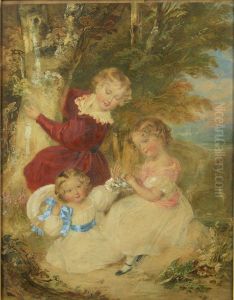Marie Francoise Corbeaux Paintings
Marie Françoise Corbeaux, also known as Fanny Corbeaux, was a French artist born in 1817. She was primarily recognized for her work in portraiture, a genre that allowed her to capture the nuances and personalities of her subjects with a particular sensitivity and skill. Despite the fact that the historical record of her life and works is limited, what is known about Corbeaux reflects the challenges and limitations faced by female artists in the 19th century.
Corbeaux's artistic career unfolded during a time when women were largely excluded from formal art education and were often discouraged or barred from pursuing professional careers in the arts. Despite these obstacles, some women managed to gain recognition for their talents, often through familial connections or private tutelage. Unfortunately, for many, including Corbeaux, their contributions have been overshadowed by their male counterparts or simply lost to time.
Marie Françoise's work was characterized by its fine detail, delicate brushwork, and emotional depth. Her portraits not only reflected the physical likeness of her subjects but also aimed to capture their inner life, a quality that distinguished her in her field. She exhibited her work in Paris, where she participated in the Salon, the official art exhibition of the Académie des Beaux-Arts in Paris. The Salon was the most prestigious art event in the Western world at the time and being able to exhibit there was a significant achievement for any artist, particularly for a woman.
The historical record does not provide a comprehensive account of Corbeaux's life, including her training and the breadth of her work. It is also unclear how her career progressed or how her style evolved over the years due to the scarcity of surviving works or detailed documentation of her exhibitions. What is known is that her life was tragically cut short when she died in 1848, at the age of 31. The cause of her death is not widely documented, which is not uncommon for historical figures whose lives were not meticulously recorded or celebrated in their time.
Despite her untimely death, Marie Françoise Corbeaux remains a figure of interest for those studying the role and recognition of female artists in the 19th century. Her story is emblematic of the many talented women whose contributions to the arts have been marginalized or forgotten. As art historians continue to re-evaluate the canon and uncover the stories of lesser-known artists, the work and life of artists like Corbeaux become increasingly valuable for understanding the broader narrative of art history and the diverse array of voices that have shaped it.
